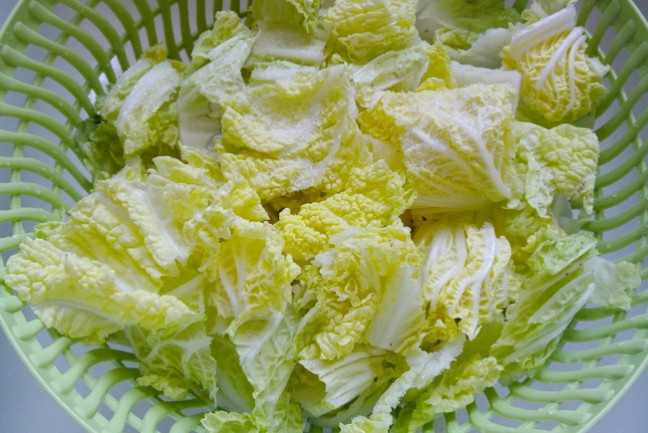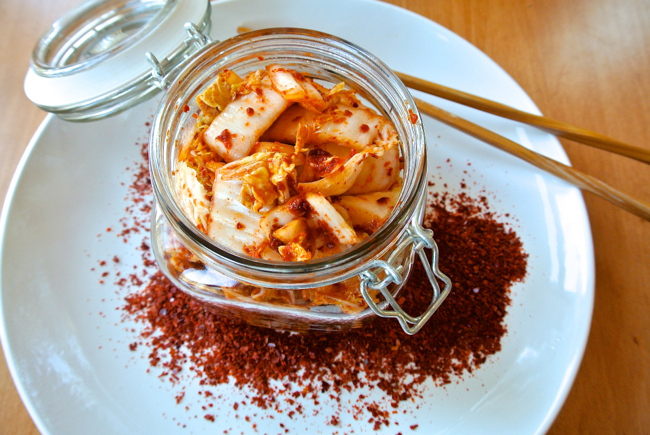In our Off the Menu: Asian America story on Korean adoptee cooks by Matthew Salesses, we feature Kim Sunée. Sunée was adopted at a young age from South Korea, and raised in the Southern U.S. She has written two books: Trail of Crumbs: Hunger, Love, and the Search for Home (Grand Central Publishing), and most recently in 2014, A Mouthful of Stars: A Constellation of Favorite Recipes from My World Travels (Andrews McMeel). Sunée has been a guest judge on Iron Chef America and is currently a food columnist for Alaska Dispatch. She freelances as a recipe tester, editor, and food stylist. Here, she shares her recipe for fresh kimchi.

Basic Fresh Kimchi
Makes about 6 cups
Mention kimchi and watch many people squinch up their nose. Admittedly, it has a bit of a stinky reputation, but I love it just when it’s about to turn funky yet still maintains its crunch and vigor. For the kimchi averse, I make this quick recipe that is more like a salad and does not require fermentation, as traditional kimchi does. I like to make this with napa cabbage, bok choy, or green cabbage. Many recipes call for a sweet rice paste to help bind the spices to the cabbage, but you can also use pear juice. For more delicate palates, decrease the amount of chile powder. Serve with Pork Belly Korean-Style BBQ (page 14 in A Mouthful of Stars: A Constellation of Favorite Recipes from My World Travels), as a side salad to grilled meats and fish, on tacos or sandwiches, puréed into soups, or over steamed rice.
1 medium to large head napa cabbage (about 2 pounds), trimmed of any loose or discolored leaves
2 tablespoons salt
1 firm but ripe pear (preferably asian), cored and chopped
¾ cup gochugaru (coarse Korean red chile powder; for a less spicy version decrease to ½ cup)
¼ cup coarsely grated fresh ginger
2 tablespoons light soy sauce
1 to 2 tablespoons ground chile paste, such as sambal oelek
1 tablespoon fish sauce (optional)
4 to 6 cloves garlic
4 carrots (about 6 ounces), cut into 2-inch matchsticks
1 medium daikon radish, cut into 2-inch matchsticks

1.) Cut the cabbage lengthwise into quarters; remove the core, and chop into about 1-inch-wide (bite-size) pieces. Place half of the cabbage in a large colander in the sink; sprinkle with 1 tablespoon of the salt. Add the remaining half of the cabbage and top with the remaining 1 tablespoon salt. Let sit for 10 minutes. Using tongs or your hands, turn the cabbage so that the bottom layer is on top; let sit for another 15 minutes. Rinse the cabbage, drain thoroughly, and pat dry or spin dry in a salad spinner.
2.) Combine the pear, gochugaru, ginger, soy sauce, chile paste, fish sauce, if using, and garlic in the bowl of a food processor and pulse until just blended. Pour the mixture into a large bowl. Add the carrots and radish; toss to combine. Add the drained cabbage; toss to combine. Let sit, covered, in the refrigerator for 30 minutes. Drain again. Store in an airtight container in the refrigerator for 3 to 4 days. It’s still good for up to a week or so, but it will start getting a little funky and taste more like the fermented kimchi of ill repute.

From A Mouthful of Stars: A Constellation of Favorite Recipes from My World Travels by Kim Sunée / Andrews McMeel Publishing, LLC.
This post is a part of Off the Menu: Asian America, a multimedia project between the Center for Asian American Media and KQED, featuring a one-hour PBS primetime special by award-winning filmmaker Grace Lee (American Revolutionary: The Evolution of Grace Lee Boggs), original stories and web content.




